|

Summer 2000 (8.2)
Pages
68-69
A Home for Azerbaijani
Folk Music
Museum
of Traditional Instruments
by
Jala Garibova
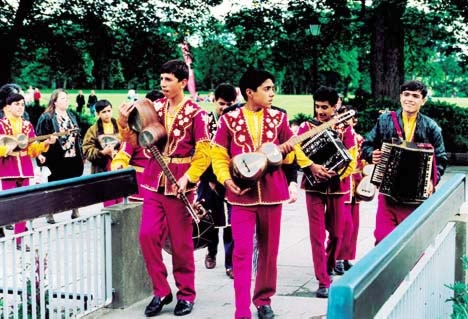
Above: Young performers of
traditional instruments. Photo: Oleg Litvin
Lovers of traditional Azerbaijani music will feel quite at home
in this quaint Baku museum that showcases folk instruments. Its
exhibits are built around the personal collection of Ahmad Bakikhanov,
one of Azerbaijan's greatest tar players. Each instrument in
the collection has its own unique story to tell, whether the
piece is an oversized tar, a replica of a 12th-century chang
or a saz shaped like a cane. To learn more about Bakikhanov's
passion for music and collecting instruments, we took a few moments
to chat with Director Zinyat Sulymanova and one of Bakikhanov's
sons, Mammadreza, a musician himself and professor at the Asaf
Zeynalli Music College.
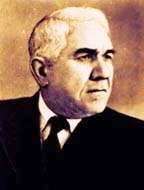  _____ _____
Ahmad Bakikhanov (1892-1973) was a distinguished tar player who
loved to collect antique Azerbaijani folk instruments. According
to his son Mammadreza, he used to have all kinds of musical instruments
in his home, including tars, kamanchas, double drums and sazes.
He built up an extensive personal collection around his favorites.
Left: Ahmad Bakikhanov, esteemed
tar player whose private collection of folk instruments provides
the foundation for the Bakikhanov Home Museum of Traditional
Instruments.
Mammadreza remembers that his father was very protective of his
treasures. "This tar dates back to the 19th century,"
explains Mammadreza, pointing to one of his father's prized string
instruments. "It has a gorgeous sound. It was my father's
favorite, but so many people would borrow it from him that he
hardly ever saw it. Then he decided to move the tuning pegs so
that the tar had to be strummed with the left hand - usually
a tar is strummed with the right hand. My father went to a lot
of trouble just to learn how to play this tar the left-handed
way so he could use this instrument."
Bakikhanov was known for organizing a folk instruments ensemble,
which still exists and is named after him. "My father had
a lot of trouble creating the ensemble," remembers Mammadreza.
"Some people tried to prevent him from including instruments
like the 'ud' or the clarinet, saying that they were not of Azerbaijani
origin. My father fought this for a long time. Uzeyir Hajibeyov,
famous for creating fusion music by combining both eastern and
western instruments in the same orchestra, supported and helped
him."
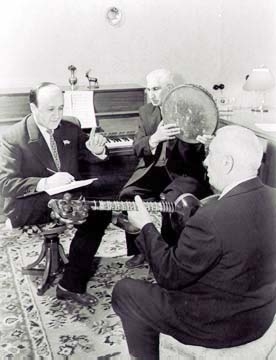  Today
Bakikhanov's collection of folk instruments is on display to
the public. His former residence is now the Museum of Music Culture,
Department of Folk Instruments. Today
Bakikhanov's collection of folk instruments is on display to
the public. His former residence is now the Museum of Music Culture,
Department of Folk Instruments.
Displayed inside are the Azerbaijani folk instruments that Bakikhanov
collected, many of them dating from the 19th century up through
the 1930s.
Left: Azerbaijani Famous
Musicians: Composer Fikrat Amirov was greatly influenced by traditional
folk melodies. Here he works with mugham performers Khan Shushinski
(holding round percussion instrument known as gaval) and Gurban
Primov with tar.
Photo: Azerbaijan
National Photo and Cinema Archives.
The purpose of the museum is to preserve and perpetuate Azerbaijan's
folk music. To encourage younger generations to learn more about
these traditions, the museum often invites music students to
come see Azerbaijan's native instruments for themselves.
The museum is rather small - only two rooms - as it used to be
Bakikhanov's apartment. "Originally, it was his uncle's
house," says Mammadreza. "My father moved here at a
young age. When I was a child, I remember a lot of famous people
used to visit our apartment, such as Seyid Shushinski and Hasan
Sayyar. Uzeyir Hajibeyov was a frequent guest. When he was visiting
us, my father wouldn't let us come out of the bedroom and disturb
them. He and Hajibeyov used to have long discussions about music."
One-of-a-Kind Instruments
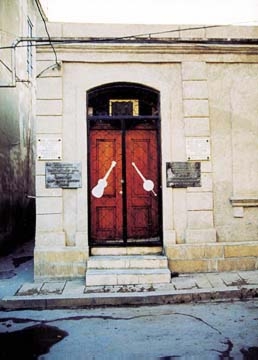  Many
of the 350 exhibits at the museum feature rare traditional instruments.
For example, there are various tars, including a 4-stringed tar
that is made like a cane. Many
of the 350 exhibits at the museum feature rare traditional instruments.
For example, there are various tars, including a 4-stringed tar
that is made like a cane.
Left: Entrance to the small
home museum that features Azerbaijan's traditional instruments.
Photo: Blair
Mammadreza recalls, "My father would take this tar on his
trips, and no one would ever guess that it was an instrument.
The timbre of such instruments is different; they have a stronger
sound and are designed for solo performances.
My father also had a violin and two sazes made like canes. My
brother gave the violin to the Moscow museum named after Glinka
(a Russian composer). My father's cane-like saz disappeared in
the 1990s; later we heard it was in Germany somewhere. One of
his students donated this cane-like saz to this museum."
Another unusual item is a bass tar, which is larger than a typical
tar. The bass tar is used in folk instrument ensembles just like
a contrabass would be used in a symphonic orchestra.
Bakikhanov also liked to collect various kinds of drums, including
a wooden double drum dating back to the 19th century. Historically,
double drums were made of wood, but he had one made that was
more like a kettledrum, with a metal frame to give it better
tuning and sound regulation.
Medieval Instruments
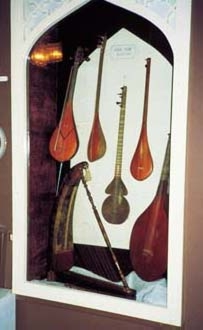  "We
also have a section for ancient Azerbaijani musical instruments,"
says Zinyat Sulymanova, the museum's Director. "These instruments,
which date from the 12th to 19th centuries, were recreated by
musicologist Majnun Karimov. He used medieval texts and miniature
paintings to reproduce replicas of Azerbaijani instruments that
have become extinct. For example, we have an example of a 'chang',
which looks much like a harp. Its silk strings are plucked with
the fingers of both hands." "We
also have a section for ancient Azerbaijani musical instruments,"
says Zinyat Sulymanova, the museum's Director. "These instruments,
which date from the 12th to 19th centuries, were recreated by
musicologist Majnun Karimov. He used medieval texts and miniature
paintings to reproduce replicas of Azerbaijani instruments that
have become extinct. For example, we have an example of a 'chang',
which looks much like a harp. Its silk strings are plucked with
the fingers of both hands."
Left: One of the exhibits
in the museum. The harp-like instrument in foreground is called
"chang". Photo: Blair
These models of ancient instruments were built in the Laboratory
for the Reconstruction of Ancient National Musical Instruments,
located in the basement of the Music Academy (For more about
Karimov's work with ancient instruments, see "Reconstruction of Azerbaijan's Medieval Instruments," by Jean Patterson,
AI 5.4, Winter 1997, page 28).
One exhibit showcases the tar, watch and pair of glasses of the
famous tar player Gurban Pirimov. The museum also has a copy
of the first record of Azerbaijani music. The recording was made
in Warsaw in 1912, when Alasgar Abdullayev performed the Bayati
Shiraz mugham there.
Another vinyl record on exhibit was produced after WW II. One
side features Bakikhanov's performance; the other side is his
student's. At the time there was an argument among musicians
how to play mugham. Everybody had different opinions, so they
wanted to document Bakikhanov's style as they considered him
an authority.
Also there are some rare photographs of early music groups, ashigs
(wandering minstrels) and khanandas (singers). A photo of Uzeyir
Hajibeyov's First Orchestra of Folk Instruments (1930) is also
on exhibit.
Bakikhanov
Traditional Instruments Home Museum
Address: 119 Zargarpalan St. Tel: (99-412) 94-60-62
Hours: Tuesday to Sunday, 10 a.m. to 6 p.m. Closed Mondays.
Ahmad Bakikhanov's son Mammadreza
and Zinyat Sulymanova were interviewed by Jala Garibova.
Alla Bayramova also helped with this article.
From Azerbaijan
International
(8.2) Summer 2000.
© Azerbaijan International 2000. All rights reserved.
Back to Index
AI 8.2 (Summer 2000)
AI Home
| Magazine Choice | Topics
| Store
| Contact
us
|





